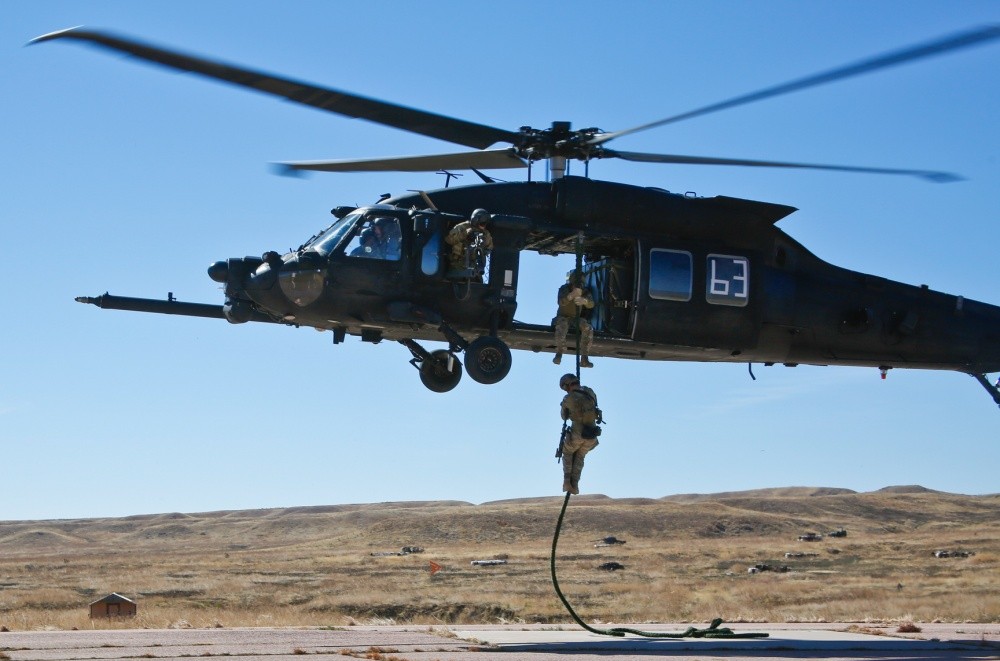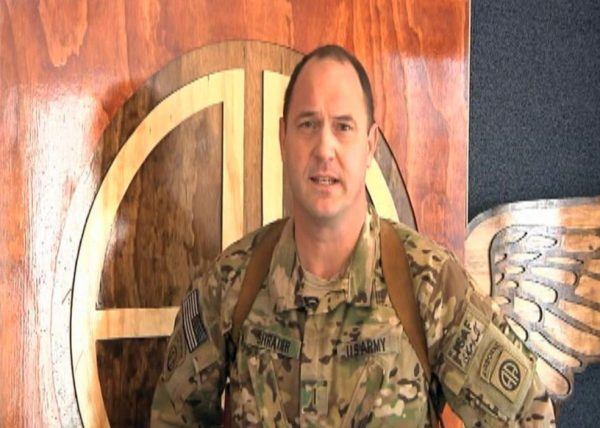In the early morning hours of Sept. 25, 1993 – eight days before the famous Battle of Mogadishu that will claim the lives of 19 Americans – an enemy rocket-propelled grenade slams into COURAGE 53, an Army UH-60 Black Hawk helicopter conducting a night reconnaissance “Eyes Over Mogadishu” mission.
The grenade blast ignites the aircraft’s fuel, killing three soldiers on board. Chief Warrant Officer (CWO) Dale Shrader and copilot CWO Perry Alliman fight to keep the helicopter in the air long enough to reach friendly lines at the port, but the helicopter crashes into a building and slams into the street. Alive, but critically injured, Shrader and Alliman are down and behind enemy lines.

In 1993 Pvt. Jason Wind was a 19-year-old combat engineer attached to “Tiger” Company, 2d Battalion, 14th Infantry Regiment of the 10th Mountain Division, part of the quick reaction force (QRF) sent to secure the crash site and evacuate the casualties. On the 25th anniversary of the battle to secure the COURAGE 53 crash site, Wind shares his account with us.
OPSLENS: What what was the situation on the night of the crash?
WIND: As part of the QRF, we were used to getting all sorts of alerts to mobilize. Most of the time we would wind up standing down without leaving the university compound or just go to the airfield and wait for nothing.
This time we got a hot “QRF get it on now” wake up call in the middle of the night. As usual, we quickly got our gear on, picked up heavy weaponry and made our way to the TOC [tactical operations center] so the COC [chain of command] can be briefed. Word got around that a bird got hit and our orders were to secure the site and look for our troops that were in the bird.
As we always traveled, we loaded up onto the back of 5-ton dump trucks lined with sandbags and made our way into the city to the site. We went straight through the city and disembarked a few hundred meters from the crash site. I actually tripped over the roll of det cord [detonation cord for explosives] I was carrying when I fell off the 5-ton, and one member of our platoon actually fell really hard and had to be medevaced out.
OPSLENS: What happened once you began approaching the crash site?
WIND: It was still very dark when we disembarked but it was getting closer to dawn. We made our way to the crash site which was near the old presidential palace. As we approached the bird, the Sammies [military slang for Somalis] were starting to organize their ambush as they certainly knew we would come. Everyone took positions in a type of T formation. We were supplemented with Humvees with MK-19 grenade launchers and several choppers above to lay waste to whatever was needed.
“As dawn approached, the Sammies started ambushing and all hell broke loose.”
I took up a position behind some dirt-rubble mound between two open buildings just around the corner from the crash with a hummer behind me. I was facing an open rubble field with Sammies a few hundred meters in the distance who came out to watch the battle!
As dawn approached, the Sammies started ambushing and all hell broke loose. I honestly can’t remember how long the battle lasted, but it was intense. We shot massive amounts of ammo, and two or three of our gunners in the Hummers got wounded. Much of the Sammy fire was coming from the hill by the palace [where the RPG that shot down Black Hawk originated]. We pummeled them with barrages of grenades and the birds above were blazing it up. Countless pieces of hot brass fell on us from the birds.
I stayed in my position the whole battle, keeping my eye on the buildings and the Sammies in the distance. They weren’t shooting from that direction but one Sammy did walk close enough to my position that i had to yell at him to leave and i had him in sight from my M-16. He eventually turned around and walked away.
After we recovered any sensitive items and bodies from the downed bird, they burned it with incendiary grenades.
Note: CWO Shrader had broken his wrist, but managed to pulled his incapacitated copilot from the burning wreckage. When he returned to rescue the other three passengers, the flames had consumed the wreck and the helicopter’s ammunition was cooking off from the heat. Shrader fought off the insurgents until he had expended his ammunition. A friendly Mogadishu resident rushed up to the Americans and led them to a friendly United Nations armored personnel carrier manned by United Arab Emirates soldiers.

OPSLENS: Did anything happen on the way back to base?
WIND: We started to exfiltrate, making our way back to our release point. At this point, I finally had a chance to shoot my M16 – providing covering fire as we crossed through allies. It was during this point when an RPG exploded near a sergeant who was severely wounded, and lost his leg. He got medevaced and we eventually loaded back up and made it so safer territory near the port/airfield. At one point we stopped near a large gathering of Sammies in some market area. We were expecting some ambush, but it never came. I remember one of the NCOs jumped off the truck, ready to beat some Somali who was taunting us at the edge of the crowd. He was wisely held back. Then our medic passed out from exhaustion.
“This incident should have been a huge wake up call to the military leadership in theater considering two more birds would be shot down by the same exact method less then 2 weeks later.”
We eventually made our way back to the compound to clean our weapons, resupply, rest, and awaited further orders if necessary. This incident should have been a huge wake up call to the military leadership in theater considering two more birds would be shot down by the same exact method less then 2 weeks later.
The fallen soldiers from the crash: Pfc. Matthew K. Anderson, 21, of Lucas, Iowa; Sgt. Eugene Williams, 26, of Chicago; and Sgt. Ferdinan C. Richardson, 27, of Summerhead, Calif.
















